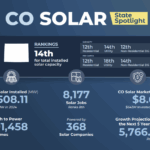
Since originating in 2006, the Solar Investment Tax Credit (ITC) has stimulated tremendous growth across residential and commercial photovoltaic markets, vaulting the U.S. to become a top 3 global solar leader.
As the current policy regime maintains a stabilized 30% credit through 2032, solar stakeholders are ready to capitalize on this unique incentive era to accelerate adoption further. This report explains the latest eligibility parameters, quantification approaches, projected economic impacts, and potential risks associated with the solar panel tax credit.
Table of Contents
Background
Initially established as a 2-year incentive under the Energy Policy Act of 2005, the early solar ITC offered 15% credits for residential customers and 30% for commercial projects off installed system costs.
Following strong initial uptake, legislators enacted multi-year extensions while expanding qualifying equipment. The Emergency Economic Stabilization Act of 2008 lifted the credit to equal 30% for both customer classes.
While the credit dipped from 30% to 26% in 2020 before the Consolidated Appropriations Act reinstated the 30% baseline, the Inflation Reduction Act passed last August cemented unmatched longevity at this maximum rate through 2032.
Meanwhile, lifting previous purchase caps introduced scope for more ambitious utility-scale ventures. This stability promises to supercharge solar markets with pending phase-downs thereafter, giving way to permanent 10% commercial credits post-2034.
Solar ITC Eligibility Rules
Taxpayers pursuing solar tax credits must satisfy certain project criteria to receive Internal Revenue Service endorsements confirming underway installations adhere to codified qualifications:
- Placed-in-Service Requirement – Systems must become operational in the tax year when credits get claimed. Partially completed projects may still qualify via safe harbor guidance.
- Permitted Properties – Primary residences, second homes, and multifamily apartment housing meet location requirements. Rental properties held as business investments likewise apply.
- System Ownership – Direct solar project ownership establishes eligibility, though certain solar leases/loans letting tenants claim credits also work. Independent system components qualify like solar water heating retrofits onto existing arrays.
- Tax Liability Thresholds – Tax filers without past year income tax burdens exceeding projected credit values lose compensation abilities for unused balances without tax equity financing workarounds.
- New Equipment Mandate – While expansions onto existing solar arrays qualify, credits exclusively apply for newly manufactured components rather than resales of used gear.
Credit Calculation Methodology
Quantifying available solar tax credits requires tallying system expenditures on the solar asset itself and then applying the appropriate credit percentage:
- Qualified Costs – Items involved directly in renewable power generation, like solar modules, inverters, racking, and housing structures, apply toward the investment base.
- Non-Qualified Costs – Peripheral system expenses unrelated to electricity creation, such as battery storage retrofits, EV chargers, or electrical upgrades, do not tally toward the credit. These become eligible for their discrete incentives.
- Fair Market Valuations – For DIY component builds or self-installations, taxpayers must document fair price assessments on hardware purchases that formed part of the system costs.
Once the qualified investment amount is established, taxpayers multiply that by 0.3 (the 30% credit rate) to determine the exact ITC benefit amount they may claim for the subject tax year.
Projected Economic Impact

Extending solar ITC availability through 2034 at the elevated 30% rate promises to supercharge an already surging residential solar sector, allowing more families to embrace renewable power, energy independence, and insulation from utility rate volatility.
Yet the unpredictability around phase-down criteria and intensity beyond 2034 likely limits longer-term forecasts and full net present value assessments on investments:
- 2023-2032 – With locked-in 30% credits, residential market growth should easily maintain a consistent 25% year-over-year installation pace. Expectations likely won’t slow until phase-down impacts materialize.
- 2033 Onward – The four-year glide path starting at 26% credits in 2033 makes valuation projections hazy for investments relying on the lower 10% commercial credit left after that. ITC-driven solar investments will trend toward earlier payback timing.
- Price Declines – Continued solar infrastructure buildouts because of the extended ITC may drive hardware and soft costs lower from growing competition, improving viability absent the credits long term. But supply chain disruptions could also unsettle pricing.
The ITC regime promises over $42 billion in direct taxpayer funds committed toward decarbonization efforts plus untold follow-on ROI from maturing solar industries, improving vulnerability from fuel shocks.
Potential Challenges
Countervailing risks surround solar tax credit reliance, including international trade disputes given overseas module sourcing, state-level growing pains supporting influxes of projects, and persistent calls to reduce federal subsidies by fiscal conservatives. Such uncertainty mandates prudent consumer protections:
- Import Circumvention Investigations – Ongoing U.S. probes into alleged Chinese/Southeast Asian solar manufacturers illegally avoiding tariffs risk future duties that dampen equipment cost savings. Though still widely seen as unlikely due to buyer protections.
- Net Metering Fights – Many utilities push back on rooftop solar proliferation, threatening their revenues and lobbying to impose grid access fees on ITC projects that undermine ROI. Consumers should confirm local net metering stability.
- General Tax Reform – Lobbying efforts continue toward simplifying America’s byzantine tax code infrastructure that could roll back inducements benefiting renewable deals.
Forward-looking accrual clauses within pending proposals aimed at reducing deficits could retroactively impact works-in-progress.
While the 10-year ITC extension promises extraordinary solar expansion, homeowners and businesses should stay vigilant on outlying factors that could disrupt long-term value flows. Careful due diligence better insulates investments.
Conclusion
With the solar ITC now guaranteed at 30% deductions against project costs for residential builds through the end of 2032, homeowners have an unprecedented opportunity to adopt renewable energy, battery backups, and electric vehicles at reduced effective expense levels. This policy’s durability promises to unlock immense distributed solar potential.
Still, eventual step-downs starting in 2033 mean procrastinators risk diminished incentives. Educating oneself on qualification details while accelerating adoption timelines hedges such exposure.
Partner with reputable local solar installers to guide appropriate system rightsizing and financing structures, maximizing benefits relative to your tax scenario.


